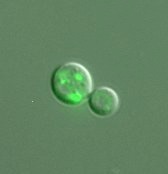 The Mitofun project looks at MITOchondria as regulators of FUNgal virulence. Mitochondria is a network within a cell where it’s energy is generated. The project aims to discover how mitochondrial function and their ability to change shape and structure regulate the virulence of fungal pathogens.
The Mitofun project looks at MITOchondria as regulators of FUNgal virulence. Mitochondria is a network within a cell where it’s energy is generated. The project aims to discover how mitochondrial function and their ability to change shape and structure regulate the virulence of fungal pathogens.

This is a microscopic image of a yeast cell C. gattii expressing mitochondrial marker HEM15 tagged with a green fluorescent protein (green signal represents mitochondria).
Fungal diseases represent a significant and growing threat to human health. Worldwide, 1.5 million people are thought to die of invasive fungal infections such as candidiasis, cryptococcosis or aspergillosis every year.
We need to understand how fungal virulence evolves in order to guide future therapies and inform fundamental research. We believe that a key regulator of fungal virulence in animal hosts is the activity of the fungal mitochondria. By combining genetic and cell biological approaches together with a high-resolution imaging and animal infection model, we aim to prove this theory which will revolutionise our understanding and treatment of fungal diseases in a wide variety of hosts.
This £1.5 million pioneering project, is funded by the European Union’s 7th Framework Programme through the European Research Council. Based in Professor Robin May’s lab at the University of Birmingham, UK, Mitofun began in 2014 and over the next 6 years will work with a number of international collaborators to achieve it’s aims. For further information please do get in touch.
This project is funded by the European Research Council under the European Union’s Framework 7 Programme (FP/2007-2013)/ERC Grant Agreement No. 614562


